

Professional Nursing Writing Services for ADN, BSN, MSN, and DNP Studies
Get your nursing homework and papers crafted by expert writers. Fast delivery, original content, and student-friendly prices guaranteed!
Receive Top-Notch Nursing Writing Help from Expert Nursing Writers
Benefits of choosing nursing study, time efficiency.
Delegate writing to our nursing service. Focus on crucial activities while we enhance your academic efficiency.
Zero Plagiarism
Nursing Study values originality, ensuring every paper is plagiarism-free with serious consequences.
Customized Papers
Provide your instructions, and our nursing writers will craft a paper tailored to meet your expectations.
Professional Quality
With extensive experience, our professionals deliver high-quality content, ensuring excellent grades.
Meet nursing study – Your Partner in Academic Success!
Navigating the demanding world of nursing education can be challenging. At nursingstudy.org, we are dedicated to accelerating the progress of nursing students, allowing a harmonious balance between work, school, and family.
Our proficient nursing essay writers specialize in crafting top-notch nursing essays, papers, and research papers. Through a stringent hiring process, we select writers well-versed in the nursing continuum, ready to tackle your nursing coursework.
Let us simplify your academic journey and boost your grades. Whether it’s any subject, tight deadline, or specific instructions, nursingstudy.org delivers exactly what you need.
If you’re a busy nursing student in a BSN/APN, MSN, or DNP program juggling coursework and work commitments, our nursing paper writing help is your solution. Let us manage your workload, ensuring timely submission of high-quality papers.
Choose nursingstudy.org for seamless academic support – from nursing homework to papers, we’ve got you covered!

The Ultimate Solution for Nursing Homework and Papers
Nursing writing services for working nursing students.
Seeking expert assistance with nursing essays, assignments, capstones, and projects? Nursingstudy.org is your go-to resource. Designed for busy nursing professionals juggling numerous weekly assignments, our professional nursing essay writing service prioritizes quality writing, convenience, and exceptional customer service.
With Nursingstudy.org, you’ll find the perfect nursing writer for your papers, tailored to your needs, deadlines, and instructions. Our dedicated team of nursing writers boasts extensive experience assisting students from top nursing institutions, delivering high-quality papers on time to streamline your academic journey.
Why struggle to balance your nursing coursework and work responsibilities? Our nursing writing service is here to simplify your academic workload, providing premium papers that are 100% original and delivered promptly. Don’t let nursing assignments overwhelm you. Join the hundreds of satisfied nursing students who rely on our trusted nursing writing services to excel academically while maintaining work-life balance.
Looking for reliable nursing assignment help? Look no further. Nursingstudy.org is your trusted companion in nursing education, offering unmatched convenience and top-notch quality to make your academic life easier.
We understand the challenges faced by working nursing students. Let us be your partner in achieving academic success and maintaining your well-being.
Experience top grades and convenience with our nursing writing services. Whether you’re an undergraduate, graduate, or doctoral student, we’ve got you covered. Don’t let time constraints hinder your academic progress. Our affordable nursing essay writing services offer expert assistance across various academic subjects, ensuring quality, originality, and timely delivery. Trust our skilled writers to handle your nursing assignments with professionalism and expertise . With Nursingstudy.org, quality writing and academic success are guaranteed.
Need PICOT Paper Writing Assistance?
PICOT, a vital tool in nursing, breaks down questions into key components: Patient/Problem, Intervention, Comparison, Outcome, and Time. Our experienced team offers professional PICOT writing help, ensuring your paper meets high-quality standards and deadlines. Let us simplify your PICOT paper writing process!
Contact us today to experience the difference our nursing writing services can make in your academic journey.
Challenges in Choosing the Best Nursing Essay Writing Services Online
Struggling to find reliable nursing essay writing services online? Look no further. Nursingstudy.org is here to alleviate the pressure!
Our hand-picked team of Ivy League and Oxbridge graduates ensures top-notch essays tailored to your needs, deadlines, and instructions. With over five years of experience, our skilled writers guarantee original, high-quality content for undergraduate, graduate, and doctoral students.
Why choose us? – Top Nursing Writers: Our experienced team holds advanced degrees in nursing and related fields. – On-Time Delivery: We prioritize prompt delivery, even with tight deadlines. – Affordable Pricing: Quality writing shouldn’t break the bank. Our services are reasonably priced. – Originality: Your essay is crafted from scratch, with strict adherence to our anti-plagiarism policy.
Looking for nursing assignment help? Our nursing essay writing service is your solution. Contact us today for top-notch nursing papers and essays!
Discover Expert Nursing Essay Writers for 50+ Nursing Topics
Busy nursing student seeking essay writing assistance? Look no further than nursingstudy.org! With over 50 expert nursing essay writers, we provide top-quality, tailored services to help you achieve your academic goals.
Expect 100% original essays, crafted to meet your specific requirements and the highest academic standards. Our writers are well-versed in nursing and deliver well-researched, timely essays.
We understand the challenges of balancing studies and life. That’s why we offer affordable services and flexible delivery options, including rush orders.
Don’t let deadlines overwhelm you. Order now and experience academic success with nursingstudy.org!
When to Purchase Nursing Essays Online?
Struggling to balance nursing studies with work and family commitments? Consider purchasing Nursing Essays Online from nursingstudy.org.
Here’s why: – Save time: With busy schedules, researching and writing quality papers can be daunting. – Expert writers: Our team of experienced nursing writers ensures high-quality, tailored essays. – Personalized approach: We understand your unique needs and assign writers accordingly. – Comprehensive services: From research papers to application essays, we cover it all. – Affordable pricing: Accessible services for all nursing students.
Let us simplify your Nursing Study journey. Contact us today!
Popular Nursing Topics and Ideas
Nursing subjects covered, pathophysiology, chronic disease management, legal and ethical issues in nursing, maternal child health disparities, telehealth and remote patient monitoring carematernal child health disparities, nursing education, nursing informatics and technology, oncology nursing, health assessment, orthopedic nursing, health disparities and social determinants of health, infection control in healthcare, critical care nursing, geriatric nursing, medication errors, providing care for lgbtq patients, healthcare quality improvement, cultural competence in nursing, interprofessional collaboration in healthcare, mental health stigma, psychosocial nursing, pain management, emergency and trauma nursing, ethical dilemmas in nursing practice, healthcare technology privacy and security concerns, patient centered care, patient education, ethical challenges in genetics, gastrointestinal nursing, infection control, integration of palliative care in cancer treatment, nursing burnout, patient safety in high tech settings.

Unlock Time with Online Nursing Writing Services
While most nurses possess the skills and competence, time remains a challenge for nursing assignments. Nursingstudy.org emerges as a solution, dedicated to supporting continuing and practice nurses with their nursing homework and papers. We exist not because of a lack of knowledge but to create time for those who dedicate their lives to nursing.
Explore our Nursing Writing Services for efficient support in managing your nursing assignments.
What Students Say
Yes, all nursing essay examples on NursingStudy.org are completely free to access.
Use the search bar or explore categories to easily find nursing essay examples on specific topics.
Absolutely. Our essays are curated to ensure quality and relevance, providing valuable learning resources.
Yes, confidentiality is a top priority. Your personal information and transactions are secure
Visit our “Place Order” page, select your requirements, and proceed with the easy order process.
Yes, customer satisfaction is crucial. You can request revisions until you are fully satisfied.
Absolutely. Our writers are professionals with extensive knowledge and experience in nursing.
The delivery time depends on the complexity and urgency of your order. We strive for prompt delivery.
Check our “Offers” section for current discounts and promotions on nursing essay writing services.
Reach out to our 24/7 customer support team through various contact options available on the “Contact Us” page for prompt assistance.

Nursing Case Study
Ai generator.
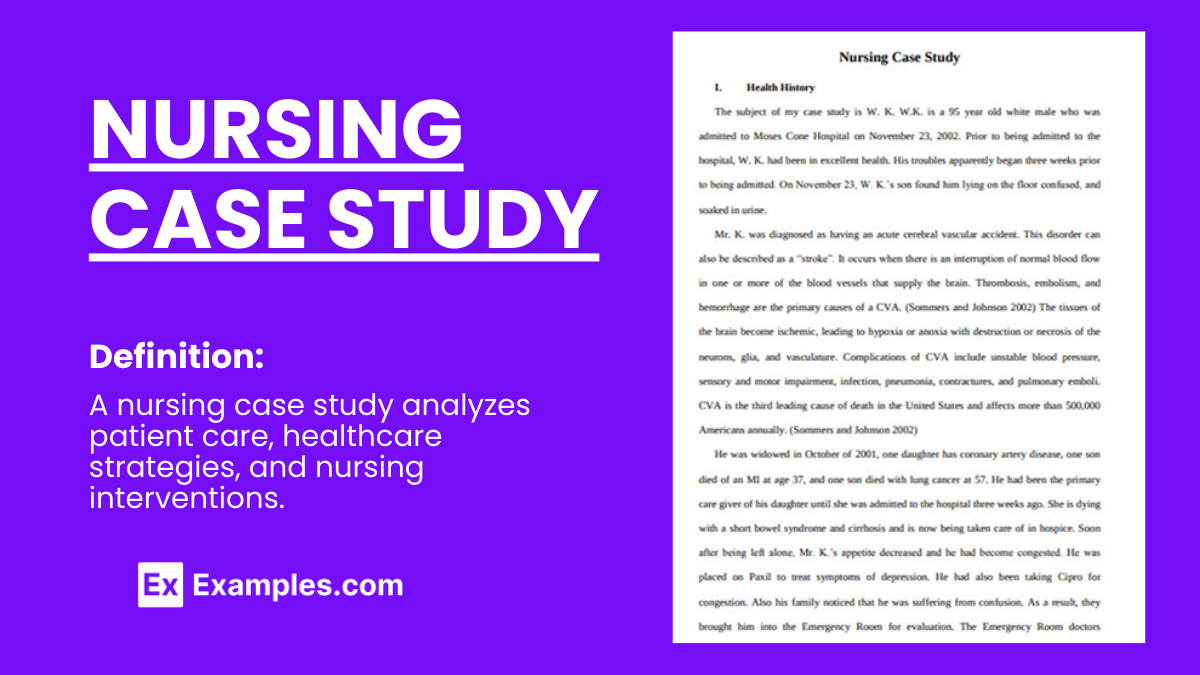
ScienceDirect posted a nursing ethics case study where an end-stage prostate cancer patient, Mr. Green, confided to nursing staff about his plan to commit suicide. The patient asked the nurse to keep it a secret. The ethical problem is whether the nurse should tell the health care team members about the patient’s thought without his permission. The best ethical decision for this nursing case study was to share this critical information with other health care professionals, which was the action the nurse took. The team adhered to the proper self-harm and suicide protocol. The appropriate team performed a palliative therapy. As a result, the patient didn’t harm himself and died peacefully a few months after he was discharged.
What Is a Nursing Case Study? A nursing case study is a detailed study of an individual patient. Through this type of research, you can gain more information about the symptoms and the medical history of a patient. It will also allow you to provide the proper diagnoses of the patient’s illness based on the symptoms he or she experienced and other affecting factors. Nursing students usually perform this study as part of their practicum, making it an essential experience because, through this research methodology , they can apply the lessons they have learned from school. The situation mentioned above was an excellent example of a nursing case study.
Nursing Case Study Format
1. introduction.
Purpose: Briefly introduces the case study, including the main health issue or condition being explored. Background: Provides context for the patient scenario, outlining the significance of the case in nursing practice. Objectives: Lists the learning objectives or goals that the case study aims to achieve.
2. Patient Information
Demographics: Age, gender, ethnicity, and relevant personal information. Medical History: Past medical history, including any chronic conditions, surgeries, or significant health events. Current Health Assessment: Presents the patient’s current health status, including symptoms, vital signs, and results from initial examinations.
3. Case Description
Clinical Presentation: Detailed description of the patient’s presentation, including physical examination findings and patient-reported symptoms. Diagnostic Findings: Summarizes diagnostic tests that were performed, including lab tests, imaging studies, and other diagnostic procedures, along with their results. Treatment Plan: Outlines the initial treatment provided to the patient, including medications, therapies, surgeries, or other interventions.
4. Nursing Care Plan
Nursing Diagnoses: Identifies the nursing diagnoses based on the assessment data. Goals and Outcomes: Establishes short-term and long-term goals for the patient’s care, including expected outcomes. Interventions: Describes specific nursing interventions planned or implemented to address each nursing diagnosis and achieve the stated goals. Evaluation: Discusses the effectiveness of the nursing interventions, including patient progress and any adjustments made to the care plan.
5. Analysis
Critical Analysis: Analyzes the case in depth, considering different aspects of patient care, decision-making processes, and the application of nursing theories and principles. Reflection: Reflects on the nursing practice, lessons learned, and how the case study has impacted the understanding and application of nursing knowledge.
6. Conclusion
Summary: Provides a concise summary of the key points from the case study, including the patient outcome and the nursing care impact. Implications for Practice: Discusses the implications of the case for nursing practice, including any changes to practice or policy that could improve patient care. Recommendations: Offers recommendations for future care or areas for further study based on the case study findings.
Examples of Nursing Case Study
Management of Acute Myocardial Infarction (AMI) Introduction: A 58-year-old male with a history of hypertension and smoking presents to the emergency department with chest pain. This case study explores the nursing management for patients with AMI. Patient Information: Demographics: 58-year-old male, smoker. Medical History: Hypertension, no previous diagnosis of heart disease. Current Health Assessment: Reports severe chest pain radiating to his left arm, sweating, and nausea. Case Description: Clinical Presentation: Patient appeared in distress, clutching his chest. Diagnostic Findings: ECG showed ST-elevation in anterior leads. Troponin levels were elevated. Treatment Plan: Immediate administration of aspirin, nitroglycerin, and morphine for pain. Referred for emergency coronary angiography. Nursing Care Plan: Nursing Diagnoses: Acute pain related to myocardial ischemia. Goals: Relieve pain and prevent further myocardial damage. Interventions: Monitoring vital signs, administering prescribed medications, and providing emotional support. Evaluation: Pain was managed effectively, and the patient was stabilized for angiography. Analysis: The timely nursing interventions contributed to stabilizing the patient’s condition, showcasing the critical role nurses play in acute care settings. Conclusion: This case highlights the importance of quick assessment and intervention in patients with AMI, emphasizing the nurse’s role in pain management and support.
Managing Type 1 Diabetes in a Pediatric Patient Introduction: A 10-year-old female diagnosed with type 1 diabetes presents for a routine check-up. This case study focuses on the nursing care plan for managing diabetes in pediatric patients. Patient Information: Demographics: 10-year-old female. Medical History: Diagnosed with type 1 diabetes six months ago. Current Health Assessment: Well-controlled blood glucose levels, but expresses difficulty with frequent insulin injections. Case Description: Clinical Presentation: Patient is active, engaging in school activities but struggles with diabetes management. Diagnostic Findings: HbA1c is 7.2%, indicating good control. Treatment Plan: Insulin therapy, carbohydrate counting, and regular blood glucose monitoring. Nursing Care Plan: Nursing Diagnoses: Risk for unstable blood glucose levels. Goals: Maintain blood glucose within target range and increase patient comfort with diabetes management. Interventions: Education on insulin pump use, dietary advice, and coping strategies. Evaluation: Patient showed interest in using an insulin pump and understood dietary recommendations. Analysis: This case emphasizes the importance of education and emotional support in managing chronic conditions in pediatric patients. Conclusion: Effective management of type 1 diabetes in children requires a comprehensive approach that includes education, technological aids, and psychological support.
Elderly Care for Alzheimer’s Disease Introduction: An 82-year-old female with Alzheimer’s disease presents with increased confusion and agitation. This case study examines the complexities of caring for elderly patients with Alzheimer’s. Patient Information: Demographics: 82-year-old female. Medical History: Alzheimer’s disease, osteoarthritis. Current Health Assessment: Increased confusion, agitation, and occasional aggression. Case Description: Clinical Presentation: Patient exhibits signs of advanced Alzheimer’s with memory loss and disorientation. Diagnostic Findings: Cognitive tests confirm the progression of Alzheimer’s. Treatment Plan: Non-pharmacological interventions for agitation, memory aids, and safety measures in the home. Nursing Care Plan: Nursing Diagnoses: Impaired memory related to Alzheimer’s disease. Goals: Reduce agitation and prevent harm. Interventions: Use of calming techniques, establishing a routine, and environmental modifications. Evaluation: Agitation was reduced, and the patient’s safety was improved through environmental adjustments. Analysis: The case underscores the need for tailored interventions to manage Alzheimer’s symptoms and improve the quality of life for the elderly. Conclusion: Nursing care for Alzheimer’s patients requires a multifaceted approach focusing on safety, symptom management, and patient dignity.
Nursing Case Study Topics with Samples to Edit & Download
- Telehealth Nursing
- Mental Health and Psychiatric Nursing
- Geriatric Nursing Care
- Palliative and End-of-Life Care
- Pediatric Nursing
- Emergency and Critical Care Nursing
- Chronic Disease Management
- Nursing Ethics and Patient Rights
- Infection Control and Prevention
- Oncology Nursing
- Nursing Leadership and Management
- Cultural Competence in Nursing
- Substance Abuse and Addiction Nursing
- Technological Innovations in Nursing
- Nursing Education and Training
Nursing Case Study Examples & Templates
1. nursing case study template.
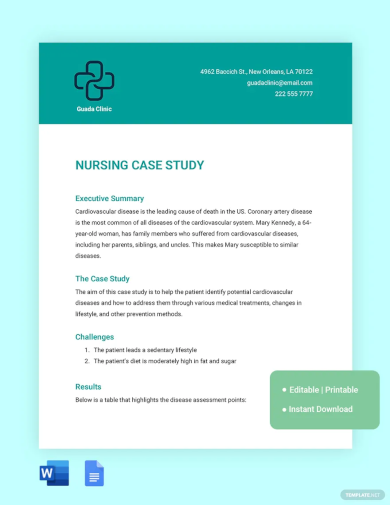
2. Free Nursing Student Care Plan Template
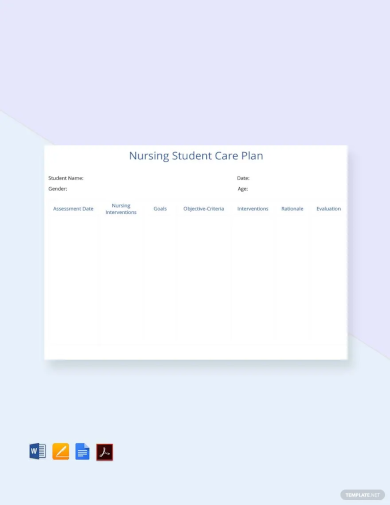
3. Nursing Action Case Study Example
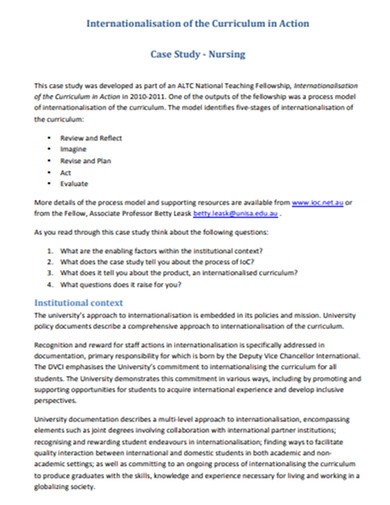
4. Hospital Nursing Care Case Study Example
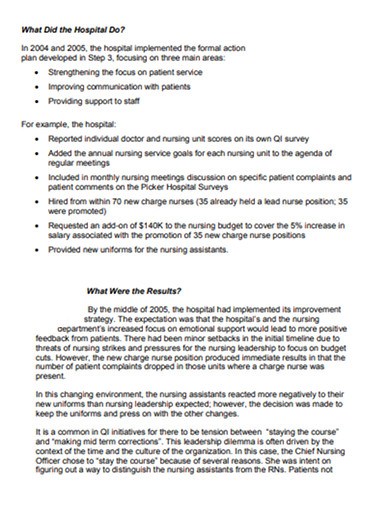
5. Printable Nursing Health Case Study Example
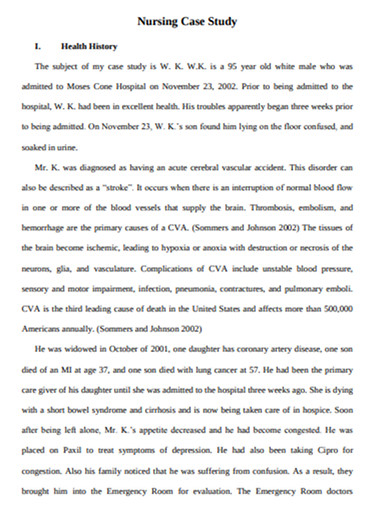
professays.com
6. Fundamentals of Nursing Case Study Example
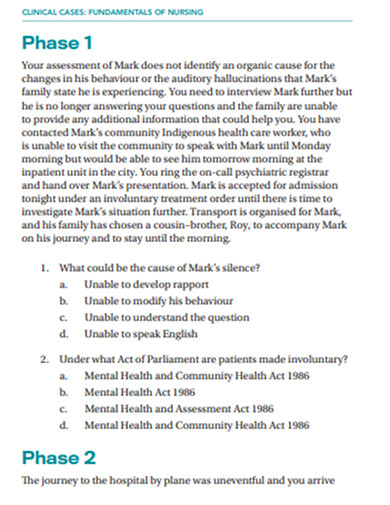
secure-ecsd.elsevier.com
7. Sample Nursing Case Study Example
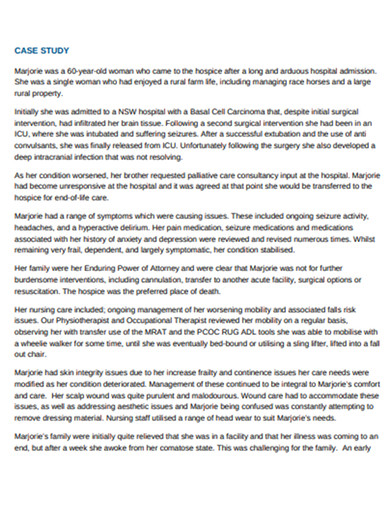
caresearch.com.au
8. Nursing Research Case Study Example
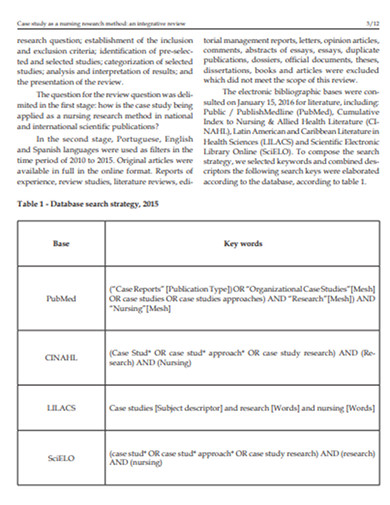
9. Standard Nursing Case Study Example
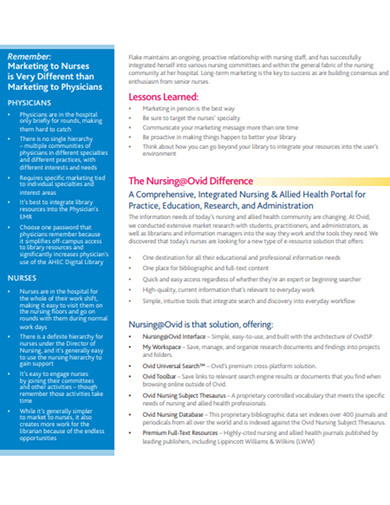
resourcecenter.ovid.com
10. Nursing Disability Case Study Example
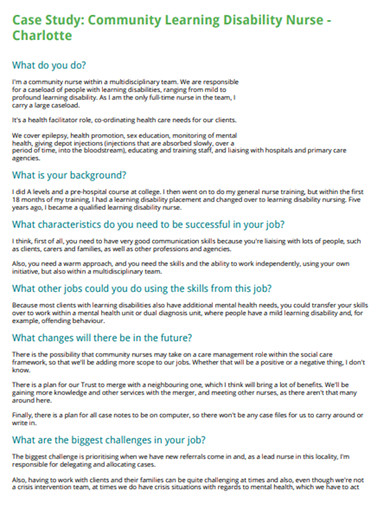
careerswales.com
11. Nursing care Patients Case Study Example
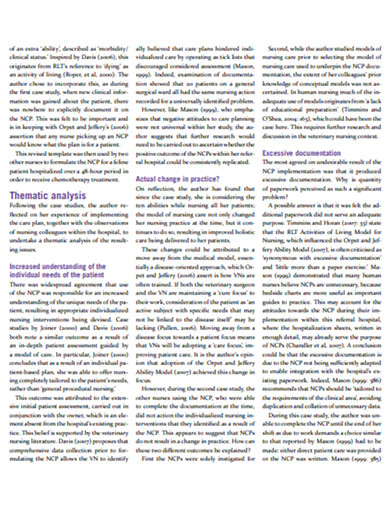
12. School of Nursing Case Study Example

ebn.bmj.com
13. Evaluation of Nursing Care Case Study Example
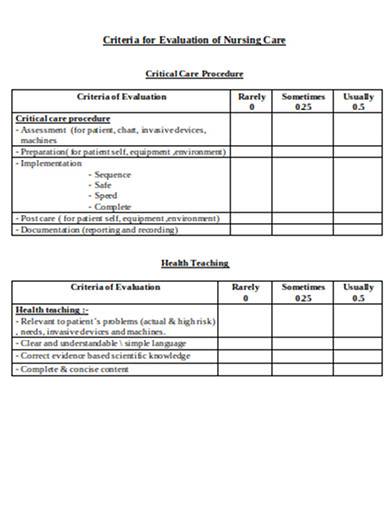
philadelphia.edu
Nursing Case Study Segments
Typically, a nursing case study contains three main categories, such as the items below.
1. The Status of a Patient
In this section, you will provide the patient’s information, such as medical history, and give the current patient’s diagnosis, condition, and treatment. Always remember to write down all the relevant information about the patient. Other items that you can collect in this stage are the reasons for the patient to seek medical care and the initial symptoms that he or she is experiencing. After that, based on the gathered information, you will explain the nature and cause of the illness of the patient.
2. The Nursing Assessment of the Patient
In this stage, you will need to prepare your evaluation of the patient’s condition. You should explain each observation that you have collected based on the vital signs and test results. You will also explain each nursing diagnosis that you have identified and determine the proper nursing care plan for the patient.
3. The Current Care Plan and Recommendations
Describe the appropriate care plan that you can recommend to the patient based on the diagnosis, current status, and prognosis in detail, including how the care plan will affect his or her life quality. If needed, you can also evaluate the patient’s existing care plan and give recommendations to enhance it. It is also crucial to cite relevant authoritative sources that will support your recommendations .
Objectives of Nursing Case Study
Nursing case studies are integral educational tools that bridge theoretical knowledge with practical application in patient care. They serve several key objectives essential for the development of nursing students and professionals. Here are the primary objectives of nursing case studies:
1. Enhance Critical Thinking and Clinical Reasoning
Case studies encourage nurses to analyze complex patient scenarios, make informed decisions, and apply critical thinking skills to solve problems. They simulate real-life situations, requiring nurses to evaluate data, consider multiple outcomes, and choose the best course of action.
2. Improve Diagnostic Skills
Through the detailed analysis of patient information, symptoms, and diagnostic results, nursing case studies help improve diagnostic skills. They allow nurses to practice interpreting clinical data to identify patient conditions and understand the underlying causes of symptoms.
3. Facilitate Application of Theoretical Knowledge
Nursing case studies provide a direct bridge between classroom learning and clinical practice. They offer a practical venue for applying theoretical knowledge about anatomy, physiology, pharmacology, and nursing theories to real-world patient care situations.
4. Promote Understanding of Comprehensive Patient Care
These studies emphasize the importance of holistic care, considering the physical, emotional, social, and psychological aspects of patient well-being. Nurses learn to develop comprehensive care plans that address all facets of a patient’s health.
5. Encourage Reflective Practice and Self-Assessment
Reflecting on case study outcomes enables nurses to evaluate their own decision-making processes, clinical judgments, and actions. This self-assessment promotes continuous learning and professional growth by identifying areas for improvement.
6. Foster Interdisciplinary Collaboration
Case studies often involve scenarios that require collaboration among healthcare professionals from various disciplines. They teach nurses the value of teamwork, communication, and the integration of different expertise to achieve optimal patient outcomes.
7. Enhance Patient Education and Advocacy Skills
By working through case studies, nurses improve their ability to educate patients and families about health conditions, treatment plans, and preventive measures. They also learn to advocate for their patients’ needs and preferences within the healthcare system.
8. Prepare for Real-Life Challenges
Nursing case studies prepare students and new nurses for the unpredictability and challenges of real-life clinical settings. They provide safe, controlled environments to practice responses to emergencies, ethical dilemmas, and complex patient needs without the risk of actual harm.
Steps in Nursing Process
Whether you are handling a patient with schizophrenia, pneumonia, diabetes, appendicitis, hypertension, COPD, etc, you will need to follow specific steps to ensure that you are executing the critical nursing process.
1. Assess the Patient
The first step of the nursing process requires critical thinking skills as it involves gathering both subjective and objective data. Subjective data includes verbal statements that you can collect from the patient or caregiver. In contrast, objective information refers to measurable and tangible data, such as vital signs, height, weight, etc. You can also use other sources of information, such as electronic health records, and friends that are in direct contact with the patient.
2. Diagnose the Patient
This critical step will help you in the next steps, such as planning and implementation of patient care. In this step, you will formulate a nursing diagnosis by applying clinical judgment. As a nurse, the North American Nursing Diagnosis Association (NANDA) will give you an up-to-date nursing diagnosis list, which will allow you to form a diagnosis based on the actual health problem.
3. Plan for a Proper Patient Care Plan
This part is where you will plan out the appropriate care plan for the patient. You will set this goal following the evidence-based practice (EDP) guidelines. The goal you will set should be specific, measurable, attainable, realistic, and timely ( SMART ).
4. Implement the Plan
In this stage, you can execute the plan that you have developed in the previous step. The implementation may need interventions such as a cardiac monitor, medication administration, etc.
5. Evaluate the Results
It is crucial to remember that every time the team does an intervention, you must do a reassessment to ensure that the process will lead to a positive result. You may need to reassess the patient depending on his progress, and the care plan may be modified based on the reassessment result.
Where to find nursing case studies?
Nursing case studies can be found in a variety of academic, professional, and medical resources. Here are some key places to look for nursing case studies:
- Academic Journals : Many academic journals focus on nursing and healthcare and publish case studies regularly. Examples include the “Journal of Clinical Nursing,” “Nursing Case Studies,” and “American Journal of Nursing.”
- University and College Libraries : Many academic institutions provide access to databases and journals that contain nursing case studies. Libraries often have subscriptions to these resources.
- Online Medical Libraries : Websites like PubMed, ScienceDirect, and Wiley Online Library offer a vast collection of nursing and medical case studies.
- Professional Nursing Organizations : Organizations such as the American Nurses Association (ANA) and the National League for Nursing (NLN) often provide resources, including case studies, for their members.
- Nursing Education Websites : Websites dedicated to nursing education, such as Lippincott NursingCenter and Nurse.com, often feature case studies for educational purposes.
- Government Health Websites : The Centers for Disease Control and Prevention (CDC) and the World Health Organization (WHO) sometimes publish case studies related to public health nursing and disease outbreaks.
- Nursing Textbooks and eBooks : Many nursing textbooks and eBooks include case studies to illustrate key concepts and scenarios encountered in practice.
- Online Nursing Forums and Communities : Forums and online communities for nursing professionals may share or discuss case studies as part of their content.
- Conference Proceedings : Nursing and healthcare conferences often include presentations of case studies. Many of these are published in the conference proceedings, which may be accessible online.
Carrying out a nursing case study can be a delicate task since it puts the life of a person at stake. Thus, it requires a thorough investigation. With that said, it is essential to gain intensive knowledge about this type of study. Today, we have discussed an overview of how to conduct a nursing case study. However, if you think that you are having problems with your writing skills , we recommend you to consider looking for an essay writing service from the experts in the nursing department to ensure that the output follows the appropriate writing style and terminology.
Text prompt
- Instructive
- Professional
10 Examples of Public speaking
20 Examples of Gas lighting
- General Nursing
- Nursing Specialties
- Nursing Students
- United States Nursing
- World Nursing
- School Rankings
- Boards of Nursing
- Breakroom / Clubs
- Nurse Q&A
- Student Q&A
- Fastest BSN
- Most Affordable BSN
- Fastest MSN
- Most Affordable MSN
- Best RN to BSN
- Fastest RN to BSN
- Most Affordable RN to BSN
- Best LPN/LVN
- Fastest LPN/LVN
- Most Affordable LPN/LVN
- Fastest DNP
- Most Affordable DNP
- Medical Assistant
- Best Online Medical Assistant
- Best Accelerated Medical Assistant
- Most Affordable Medical Assistant
- Nurse Practitioner
- Pediatric NP
- Neonatal NP
- Oncology NP
- Acute Care NP
- Aesthetic NP
- Women's Health NP
- Adult-Gerontology NP
- Emergency NP
- Best RN to NP
- Psychiatric-Mental Health NP
- RN Specialties
- Best RN Jobs and Salaries
- Aesthetic Nurse
- Nursing Informatics
- Nurse Case Manager
- Forensic Nurse
- Labor and Delivery Nurse
- Psychiatric Nurse
- Pediatric Nurse
- Travel Nurse
- Telemetry Nurse
- Dermatology Nurse
- Best NP Jobs and Salaries
- Family NP (FNP)
- Orthopedic NP
- Psychiatric-Mental Health NP (PMHNP)
- Nurse Educator
- Nurse Administrator
- Certified Nurse Midwife (CNM)
- Clinical Nurse Specialist (CNS)
- Certified Registered Nurse Anesthetist (CRNA)
- Best Free Online NCLEX-RN Study Guide
- The Nursing Process
- Question Leveling
- NCLEX-RN Question Identification
- Expert NCLEX-RN Test-Taking Strategies
- Best Scrubs for Nurses
- Best Shoes for Nurses
- Best Stethoscopes for Nurses
- Best Gifts for Nurses
- Undergraduate
- How to Become an LPN/LVN
- How to Earn an ADN
- Differences Between ADN, ASN, AAS
- How to Earn a BSN
- Best MSN Concentrations
- Is an MSN Worth It?
- How to Earn a DNP
- MSN vs. DNP
Nursing Case Studies: Diagnosis, Rationales, Fundamentals
Test your knowledge and clinical investigative skills in trying to diagnose what is going on with the patients presented in each of the Case Study Investigations. Can you come up with the right diagnosis? Case Studies Articles

Case Study: Child With Altered Mental Status
In this Case Study, an 11-year-old child with autism presents by ambulance to the children's hospital with altered mental status, bizarre behavior and fever....

Four Days of Nausea, Vomiting and Fever
What is most important in this case study in which an older Vietnamese woman presents to the ER with fever, nausea and vomiting?

I'm Dizzy, Tired and Can't Remember What I Ate for Lunch
A 74-year-old white male presents to the ED with confusion, fatigue, dizziness, headache and distal right arm paresthesia. Experienced nurses, model your...

Agonizing Pelvic Pain: What's Going On with this 17-year-old? | Ca…
A new case study in which the patient, a 17-yr-old African American female, is having ongoing, excruciating pelvic pain. This case study is based upon the very...

A Fracture from a Fall: What's Going on Here?
A new case study in which a 77 yo white female arrives to the emergency room by taxi with a suspected skull fracture. This topic was suggested by a reader –...

Breathless, Coughing and Run-down: What's Going On? | Case Study
A new case study in which the patient, a 32-yr-old white male presents to a local free clinic with fatigue, moderate dyspnea, and a persistent and...

Suicidal Ideation and Muscle Twitches | Case Study
A new case study in which the patient, a 40 yr-old mixed-race woman presents to her primary care physician with concerns about suicidal ideation. She has some...

Unexplained Diarrhea and Weight Loss: What's going on? | Case Stud…
A new case study in which the patient, a 28 y/o white female presents to a primary care clinic complaining of recurrent diarrhea. She first experienced diarrhea...

Repeat After Me... What's the problem here? | Case Study
A homeless man is brought to the ER by the local police after he is found sitting at a bus stop with a bloody rag pressed to his left knee. The temperature...

Wild Mood Swings and Outbursts of Anger: What's Wrong with this M…
A new case study in which the patient, a 50-yr-old male of mixed race visits his primary care physician with concerns about wild mood swings and outbursts of...

Case Study: Does this Cherokee Woman Have Dementia?
An 85-yr-old Cherokee woman living in a skilled nursing facility has lost weight since admission and won’t socialize or join in activities. She won't...

Case Study: It's a Lump, but is it Breast Cancer?
I am so excited about this Case Study because I feel it will be useful to so many of you! Welcome to a new Case Study in which the patient, a 45-yr-old, white,...

Case Study: Newborn with Vomiting and Diarrhea
A three-day old male infant is brought to the ER by his 22-yr-old mother with vomiting and diarrhea. Diagnostic results will be released upon request, with the...

Case Study: Joint Pain, Rash, Hair Loss - What's Going On?
A new case study in which R.W. presents to her PCP with a cough, mild fever, joint stiffness and pain and a history of rashes, anemia and hair loss.

Case Study: An OB Catastrophe
The following is a case simulation involving a patient initially encountered in Labor and Delivery. While the initial encounter occurred in a specific setting,...

Differential Case Study: Lyme Disease or Covid-19?
Lakeith, a 35-year-old black man living in New York State, presents with a fever of 101 degrees F. He is concerned he might have contracted Covid-19. Based upon...

Case Study: Sudden Severe Pain
A new case study in which the patient, D.C., a 52-year-old, white, married college professor wakes up to severe and intensifying pain. Though the coronavirus...

Case Study: Unexplained Bruises
Karen brings her daughter, Ann into the pediatric clinic stating, "She's just been so tired lately. All she wants to do is sleep and she’s got no appetite....

Case Study: What's Causing This Cough?
A new case study in which the patient, H.T. an 82-year-old Hispanic man presents to his primary care clinic with cough, malaise and confusion. How well do you...

Case Study(CSI): Stomach flu? Anxiety? What's Going on Here?
A new case study in which the patient, A.W. a 65-year-old African American woman presents to her primary care clinic with unspecified complaints. She told the...

Case Study: I'm too tired to walk the dog...
A new case study in which the patient, T.K. a 51-year-old woman who has finally taken a staycation, doesn’t have enough energy to walk her dog. You’re the...

Case Study: My Stomach Hurts
It's late in the day on a beautiful Saturday in late summer. You are finishing up your shift at a local urgent care clinic when a 28-year-old, white male comes...

Case Study: Trust Your Gut? A Fecal Transplant Could Change Your L…
Fecal Microbial Transplant (FMT) is a well-accepted practice for the treatment of C. diff, however in the U.S. it is still typically used only after multiple...

Case Study: Magic Mushrooms as Medicine? Mind-Body Connection Pt. …
Can "tripping" cure depression? Can LSD reduce chronic anxiety? This article explores the use of psychedelics to treat mental illness. Read on to find links for...

Case Study: Does Childhood Abuse Prevent Weight Loss? Pt. 2
This is an important topic for nurses. We need to understand the connection between childhood trauma and mind/body issues to build trust with patients and...
- High School
- You don't have any recent items yet.
- You don't have any courses yet.
- You don't have any books yet.
- You don't have any Studylists yet.
- Information
Sample Nursing Case Study
Nursing (ncm 100), angeles university foundation.
Students also viewed
- Theories of Personality Chapter Summaries
- Affidavit of Self Accident
- Class Notes And Summary Of The Carbon Dioxide And Oxygen Cycle
- Jurado-obligations-reviewer
- Halimbawa ng Estratehiyang Dimensyunal na Pagbasa
- Variance of Ungrouped Data

Related documents
- Japan - notes
- Scanned Documents - Notes
- Second quarter test in english 10
- Testmanship December 2024
- Module 1 - Eastern Philosophies that includes Confucianism and other types of eastern Philosophies.
Related Studylists
Preview text, nursing case study, 2200 – ob ward, submitted by: liana monique san lorenzo, bsn3-2; rle group 2, submitted to: ms. vicencio, october 15, 2013, nursing case study, admission diagnosis:, g2p1 (1001) pregnancy, uterine,term, cephalic, final diagnosis:, g2p2 (2002) pregnancy, uterine,term, cephalic delivered, live birth by vsd with right, mediolateral episiotomy and repair, i. health history, a. demographic (biographical data), 1. client’s initials: h. h. m., 2. gender (sex): female, 3. age, birthdate and birthplace: 30 y/o, may 11, 1983, trece martires city, 4. marital (civil) status: married, 5. race and nationality: filipino, 6. religion: baptist, 7. address and telephone number: b41 l40 pontevedra tiera solana,, buenavista 3, general trias, cavite, 8. educational background: college graduate, 9. occupation (usual and present): japanese interpreter, 10 source of medical care: clinic – physician, b. source and reliability of information, the patient was competent to provide information. she was able to speak clearly, and was conscious, coherent and conversant. the patient’s chart was also used as a, secondary source of information., c. chief complaints, “biglang sumakit ung tiyan ko.”, “humihilab na ung pakiramdam ng tyan ko.”, “ka-buwanan ko na kasi.”, f. family history (family tree or genogram), paternal maternal.
Legend: UA - Unrecalled age UCD - Unrecalled cause of death A & W- Alive and Well
- Male - Deceased
The genogram presented in the previous page shows three generation of the
Patient’s family. based on the genogram, the client’s family has a history of endocrine, disorders such as diabetes mellitus which she can acquire due to genetics. other, diseases could be inherited due to the uncertainty in the cause of death of her, grandparents., the said diseases could be prevented by modification of lifestyle and proper, a & w, g. socio-economic, family member /, relationship to, occupation /, source of income monthly income.
(Patient) K. H. M. (Son) M. B. H (Brother).
Japanese Interpreter ‘ N/A
Office Worker
12,000 / Month
10,000 / Month
The client’s family is an extended type. Her husband is a seaman and he is
Already 6 months away from home. the salary of her husband was not disclosed. the, patient has been working as a japanese interpreter for 17 years and says that her pay, is enough for her family’s needs. her brother also lives with them and helps in paying, h. developmental history, patient's age: 30 years old, developmental stage: young adulthood, developmental task: intimacy vs. isolation, relationships are important to person included in the young adults age group. it is the, time where they want to start a family, have lasting friends and a strong family, relationship. young adults need to form intimate, loving relationships with other people, to make them feel successful and on track. success leads to strong relationships, while, failure results in loneliness and isolation., as for the patient’s case, the patient has a loving husband, whom she loves as well and, she says that she still feels butterflies “kinikilig” due to her husband. she said that she, was lucky and she loves her son and her soon to be daughter so much. she said she, was also contented with her family and friends..
With evenly distributed hair along the scalp Good hair distribution Palpation: Smooth and silky to touch
NAILS Inspection: Fingernails and toe nails are clean and trimmed Pinkish nails
Palpation: Nails form 160° angle at base, hard, smooth and immobile (+) smooth cuticles With good capillary refill of 2 seconds
“Hindi naman masakit ang ulo ko.”
Inspection: Head is round and symmetrical; appropriate to the size of the body (-) lesions on the scalp Face is oval and symmetric Normocephalic
Palpation: Smooth and hard skull Good ROM of TMJ (-) lumps, masses and tenderness (-) head depressions or elevations
d. Eyes “Hindi naman Malabo
ang mga mata ko.”
Inspection: Visual fields intact Symmetrical blinking
Conjunctiva and sclera appear moist and smooth (+) PERRLA No discharges
Palpation: No drainage noted when nasolacrimal duct is palpated
e. Ears “Wala ako problema
sa pandinig.”
Inspection: Equal in size bilaterally Auricles aligned with the corner of each eye within a 10-degree angle of vertical position No discharges
Palpation: Skin smooth (+) firm cartilages Recoils easily when folded No tophi ‘No tenderness upon palpation
f. Nose and Sinuses “Wala naman akong
Inspection: Nose is smooth and symmetric Nose has same color as the face Client was able to identify odors presented (orange and perfume) (+) red glow; frontal and maxillary sinuses transilluminate (-) lesions (-) epistaxis (-) nasal flaring (-) nasal discharge
i. Breast and Axillary “Okay lang naman.” Inspection:
Breast skin pale pink with pink areola Prominent Montgomery tubercles Nipples everted bilaterally Hyperpigmented nipples and areola (+)Excretion of colostrum
Palpation: No masses or tenderness palpated
j. Respiratory ”Hindi naman ako
kinakapos sa hininga.”
Inspection: Chest expansion symmetric Scapula are symmetric and prominent Sternum in midline and level with ribs Palpation: (-) tenderness (-) masses
Percussion: Resonant
Auscultation: No adventitious sounds present Lung sounds are clear on both lung fields.
k. Cardiovascular “okay naman.” Inspection:
(-) jugular vein distention and non- visible (-) varicose veins on both legs near popliteal area (-) abnormal discoloration of the palms and soles of the
Palpation: Carotid pulse equal bilaterally, 3+ PR = 88 bpm, 3+ BP = 130/80 mm Hg (+) apical pulse felt at 5 th ICS LMCL With good capillary bed refill of 2 seconds 3+ radial pulses and in other sites are easy to palpate
Auscultation: Heart sound are rhythmic, regular beating Apical heart rate = 85 beats/min, regular rate and rhythm (-) extra heart sounds No splitting of heart sound, snaps, clicks or murmurs noted
l. Gastrointestinal “medyo masakit ung
tyan ko. Pero kaya ko pa.”
Inspection: (-) lesions on the abdominal area (-) rashes (-) abdominal discoloration Abdomen is globular, smooth, no lesion and no scar noted Umbilicus in midline (+) Striae (+) Linea nigra
Palpation: No tenderness in any quadrant Engaged fetal position
CN VIII – able to hear whispers CN IX – no difficulty in swallowing CN X – (+) Gag reflex CN XI – can shrug his shoulders against resistance CN XII – Tongue moves easily
Performs repetitive alternating movements of finger-to-nose at smooth, good pace Sensory system: identifies light touch, dull and sharp sensations to forearm Stereognosis and graphestesia intact
q. Hematologic “Di naman ako
Inspection: Nopresence of hematomas
r. Endocrine
“Di naman ako pawisin”
Inspection: (-) tremors (-) ABN hair distribution (-) diaphoresis
2. LABORATORY STUDIES/DIAGNOSTICS
Procedure / Date Indication Normal Values/ Findings
Actual Findings
Nursing Responsibilities/ Implications (Pre, Intra, Post)
3. OTHER ASSESSMENT TOOLS (Scale, Sheet, Grade, Level, etc.)
Date (s) taken Comprehensive Actual Content/Legend
Actual Result
August 13, 2013
Functional Level Code
Level 0 – Full Self Care
Level 1 – requires use of requirements or device
Level 2 – requires assistance or supervision from another person
Level 3- requires assistance or supervision from another person or device
Level 4 – Is dependent and does not participate
Feeding – Level 0
Bathing – Level 0
Toileting – Level 0
Bed Mobility – Level 0
Dressing – Level 0
Grooming – Level 0
General Mobility – Level 0
Cooking – Level 0
Home Maintenance – Level 0
Shopping – Level 0
The patient was graded as Level 0 in Functional Level Code since she can take care of herself fully prior to hospitalization.
J. FUNCTIONAL ASSESMENT (including ADL)
1. health-perception-health management pattern, the patient has a good image of her health. she says that she takes care of her, body to be able to work efficiently, and to be able to take care of her son and her future, baby. she makes sure that she eats good food and does every measures needed to, gain a healthy body., 2. self-esteem, self concept/self-perception pattern, the patient verbalized that she was happy with the relationships she has made. may, it be with her friends or with her close family. she said that she is mostly a happy, person and likes a good laugh. she said that she likes hanging out with her friends,, eating out with her family and likes bonding moments. she also has no problems with, her neighbors and she feels relieved that her neighbors and her are all friends so there, is no conflict., 8. personal habits, the client said that she has never smoked but drinks alcohol at parties, when she is, not pregnant. she said that she never even have thought of using illegal drugs and she, said that she values her health too much to engage in those kind of vices., 9. coping and stress management, the patient said that she is the type of person who likes to express her feelings and, vent things out when she is in trouble or sad. although she also said that it all depends, on the situation. she said that if other people could not help her even if they listen to her, problems, she would then keep the problem to herself; and if the problem is needed to, be said, then she will., 7. environmental hazards, the patient said that the place she lives in is safe, has a low crime rate, and are very, much accessible. she resides in a subdivision so there are very few cars passing the, streets. her only problem was the noise from her neighbors when they use the karaoke., ii. problem list, a. actual or active, problem no. problem date identified, resolved/remarks, 1 impaired comfort oct 2, 2013 oct 2, 2013, patient’s pain was, addressed. but the, pain was only, 2 anxiety related to, stress of labor, oct 2, 2013, natural because the, patient is in labor., -the patient said, that she somehow, feels scared of what, may happen but she, said that she has full, trust with the, hospital staff., b. high risk or potential, risk for ineffective, breathing pattern related, to breathing exercises, risk for fluid volume, deficit related to decrease, in oral fluid intake and, increase in diaphoresis, during labor..
- Multiple Choice
Course : Nursing (ncm 100)
University : angeles university foundation.

- Discover more from: Nursing ncm 100 Angeles University Foundation 66 Documents Go to course
- More from: Nursing ncm 100 Angeles University Foundation 66 Documents Go to course
- More from: nurs 204 by Majan Bartolome 35 35 documents Go to Studylist
Recommended for you
Nursing Case Studies with Answers
Explore Nursing Case Studies with Answers to enhance your nursing knowledge and prepare for practical scenarios. Get this template for free.

By Chloe Smith on Nov 11, 2024.
Fact Checked by Karina Jimenea.
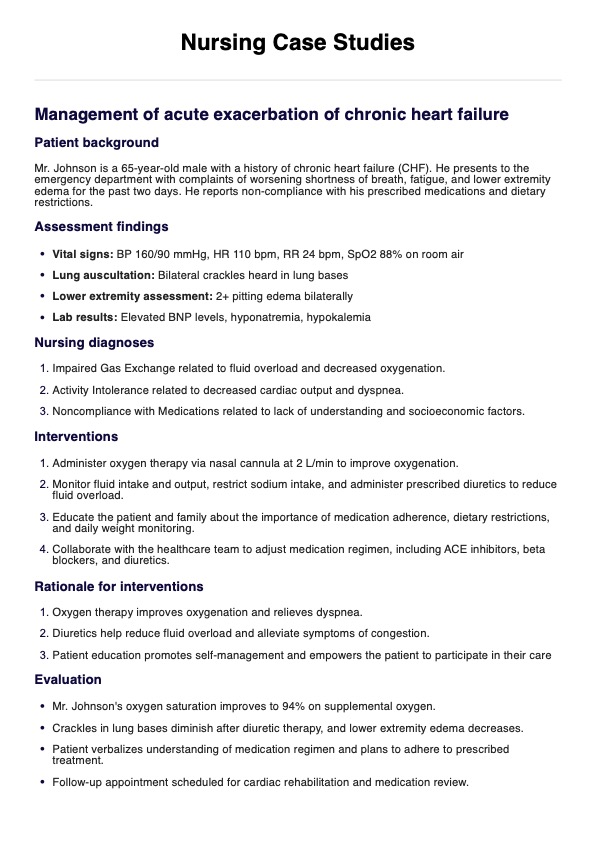
What is in a nursing case study?
A nursing case study is a detailed examination of a patient's health condition, treatment plan, and overall care journey, specifically from the perspective of nursing practice. These case studies are essential components of nursing education and professional development, providing valuable insights into clinical scenarios and patient care experiences.
Various elements are included in a case nursing study to comprehensively understand the patient's situation. A sample case study typically contains the patient's demographic information, including age, gender, medical history, and presenting symptoms. This demographic overview sets the stage for understanding the context in which healthcare interventions occur.
Moreover, nursing case studies often delve into the nursing assessment process, highlighting the initial and ongoing assessments nurses conduct to gather relevant patient health status data. These assessments involve physical examinations, vital sign monitoring, and assessment tools to identify potential health issues and risk factors.
Critical thinking skills are also essential in nursing case studies, as they enable nurses to analyze complex clinical situations, identify priority needs, and develop effective care plans tailored to individual patients. Nursing students and experienced nurses use case studies as opportunities to enhance their critical nursing knowledge and clinical practice.
Nursing Case Studies with Answers Template

Nursing Case Studies with Answers Example
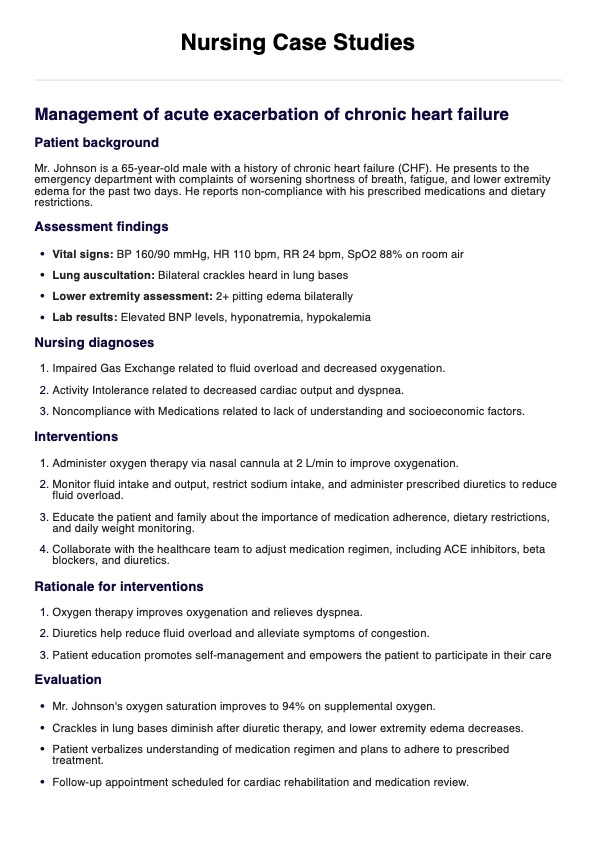
Nursing case studies serve several vital purposes within healthcare education and professional practice, whether they are a primary care physician or a group of nursing students.
Nursing case studies use clinical data to enhance clinical reasoning, bridge theoretical knowledge and practice, promote collaboration between nurses, support evidence-based practice, as well as foster professional development for nurse practitioners.
How to write a nursing case study?
Writing a nursing case study involves several essential steps to ensure accuracy, relevance, and clarity. Let's break down the process into actionable steps:
Step 1: Select a patient case
Begin by selecting a patient case that presents a relevant and compelling healthcare scenario. Consider factors such as the patient's demographic information, medical history, presenting symptoms (e.g., joint stiffness, pain), and healthcare needs (e.g., medication administration, vital signs monitoring). Choose a case that aligns with your learning objectives and offers meaningful analysis and discussion opportunities.
Step 2: Gather relevant data
Collect comprehensive data about the selected patient case, including medical records, test results, nursing assessments, and relevant healthcare documentation. Pay close attention to details such as the patient's current health status, past medical history (e.g., diabetes), treatment plans, and any ongoing concerns or challenges. Utilize assessment tools and techniques to evaluate the patient's condition thoroughly and identify areas of clinical significance.
Step 3: Assess the patient's needs
Based on the gathered data, evaluate the patient's needs, considering physical, emotional, social, and environmental factors. Assess the patient's pain levels, mobility, vital signs, and other relevant health indicators. Identify any potential complications, risks, or areas requiring immediate attention. Consider the patient's preferences, cultural background, and individualized care requirements in your assessment.
Step 4: Formulate nursing diagnoses
Based on your assessment findings, formulate nursing diagnoses that accurately reflect the patient's health needs and priorities. Identify actual and potential nursing diagnoses related to the patient's condition, considering factors such as impaired mobility, ineffective pain management, medication adherence issues, and self-care deficits.
Step 5: Develop a care plan
Develop a comprehensive care plan outlining the nursing interventions and strategies to address the patient's identified needs and nursing diagnoses. Prioritize interventions based on the patient's condition, preferences, and care goals. Include evidence-based nursing interventions to promote optimal health outcomes, manage symptoms, prevent complications, and enhance the patient's overall well-being. Collaborate with other healthcare professionals as needed to ensure coordinated care delivery.
Step 6: Implement and evaluate interventions
Implement the nursing interventions outlined in the care plan while closely monitoring the patient's response to treatment. Administer medications, provide patient education, perform nursing procedures, and coordinate care activities to effectively meet the patient's needs. Continuously evaluate the effectiveness of interventions, reassessing the patient's condition and adjusting the care plan as necessary. Document all interventions, observations, and outcomes accurately and comprehensively.
Step 7: Reflect and seek assistance
Reflect on the nursing case study process, considering what worked well, areas for improvement, and lessons learned. Seek assistance from nursing instructors, preceptors, or colleagues if you encounter challenges or have concerns about the patient's care. Collaborate with interdisciplinary team members to address complex patient issues and ensure holistic care delivery. Continuously strive to enhance your nursing practice through ongoing learning and professional development.
What is a Nursing Case Study with Answers template?
A Nursing Case Study with Answers template is a guide that presents a patient scenario for nurses to assess, analyze, and make care decisions. It includes situations to help nurses apply critical thinking and clinical knowledge.
Our Nursing Case Study with Answers template provides two examples of health issues that may occur within the health practice. It includes scenarios for managing acute exacerbation of chronic heart failure in a patient, as well as a case involving a patient with a broken bone. We've also added an extra blank section for student nurses, nurses, and other practitioners to add another example for practice and analysis.
Examples of nursing case studies
Aside from the ones included in our template, let's explore a few more examples of nursing case studies to illustrate how they are developed and analyzed:
Case study 1: Management of chronic pain in elderly patients
- Scenario : Mrs. Smith, a 75-year-old woman, is admitted to the hospital with complaints of chronic pain in her lower back and joints. She has a history of osteoarthritis and hypertension. Mrs. Smith reports difficulty performing activities of daily living due to her pain, which has been progressively worsening over the past year.
- Assessment : Nursing assessment reveals a limited range of motion, joint stiffness, and increased blood pressure readings. Mrs. Smith's pain is rated 7 out of 10 on the scale. Vital signs are within normal limits except for elevated blood pressure.
- Diagnosis : Nursing diagnosis includes chronic pain related to osteoarthritis and impaired mobility and Activity intolerance related to pain and limited joint mobility.
- Interventions : Nursing interventions focus on pain management strategies such as administering analgesic medications, providing heat therapy, and assisting with gentle exercise. Patient education is provided on proper body mechanics and joint protection techniques.
- Evaluation : Mrs. Smith's pain is reassessed regularly, and interventions are adjusted based on her response. Progress notes indicate a reduction in pain intensity, improved mobility, and increased participation in activities of daily living. Blood pressure readings are monitored closely to ensure optimal management of hypertension.
Case study 2: Family-centered care for a child with chronic illness
- Scenario : Johnny, a 6-year-old boy with cystic fibrosis, is admitted to the pediatric unit for respiratory exacerbation. His parents express concerns about managing his condition at home and coping with the emotional impact of his illness on the family.
- Assessment : Nursing assessment reveals decreased lung function, persistent cough, and increased respiratory rate. Johnny's parents report feeling overwhelmed and anxious about his health.
- Diagnosis : Nursing diagnosis includes ineffective airway clearance related to thick, tenacious secretions.
- Interventions : Nursing interventions focus on airway clearance techniques, respiratory treatments, and emotional support for Johnny and his family. Nursing staff facilitate support groups for families of children with chronic illnesses to provide mutual support and share coping strategies.
- Evaluation : Johnny's respiratory status is monitored closely, and interventions are implemented to improve airway clearance. Respiratory treatments are administered as prescribed, and progress is documented in the medical record. Johnny's parents report feeling more confident in managing his care at home and express appreciation for the support received from the healthcare team.
Commonly asked questions
In clinical terms, a case study is a detailed examination of a patient's medical history, symptoms, diagnosis, treatment, and outcomes, typically used for educational or research purposes.
Case studies are essential in nursing as they provide real-life scenarios for nurses to apply theoretical knowledge, enhance critical thinking skills, and develop practical clinical reasoning and decision-making abilities.
Case studies in nursing education offer benefits such as promoting active learning, encouraging problem-solving skills, facilitating interdisciplinary collaboration, and fostering a deeper understanding of complex healthcare situations.
Related Templates
Popular templates.
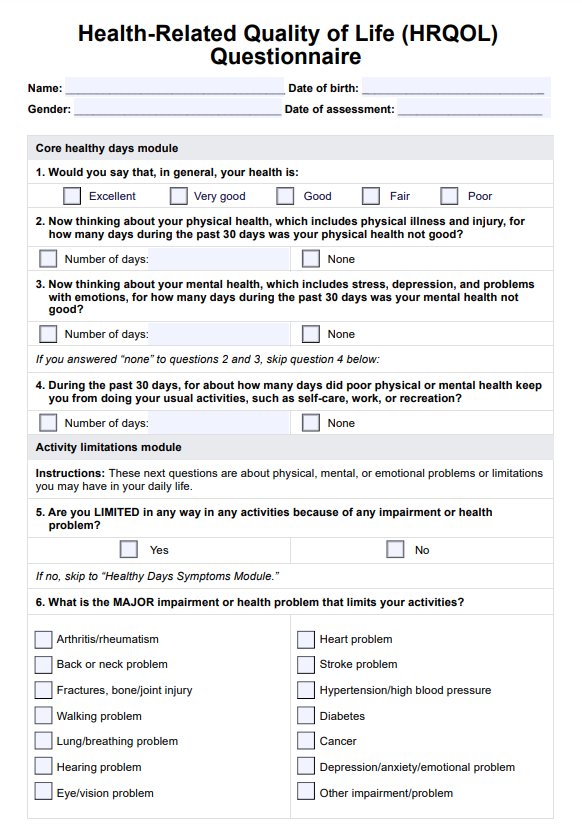
Join 10,000+ teams using Carepatron to be more productive
- +441613810000
- [email protected]
Nursing Case Study Examples + Answer Guide

- October 16, 2024
- 4 Mins Read
A nursing case study is a complete report of a patient’s expertise with an illness, treatment, or as well condition. So, it every so often comprises the patient’s medical history, signs, diagnostics tests, treatment course, and as well results. So, these case studies are a vital element in nursing education and as well career growth. Thus these case studies offer valuable and useful guides into clinical settings and patient care expertise. This article probes into a nursing case study in detail and you can compose a good case study of nursing.
Table of Contents
Tips For Composing A Good Nursing Case Study Samples + Answer
Composing a nursing case study comprises plenty of factors as a means to ensure accuracy, relevance, and also clarity. These tips are as follows.
1. Selecting The Right Case
In the first step you will need to choose the right case and this is the vital element to compose a winning nursing case study. So, a decent case study should be exciting, helpful, and also bring into line with your learning aims. As a means to select a decent and good case study, you will need to choose a patient’s health history, the care plan, and as well the results. Let suppose, a case study with a patient who has diabetes might explore the patient blood and sugar levels. Also, medication plans and lifestyle changes.
2. Perform Plenty of Full Research & Gather Data
Research is one of the main features and elements to compose a quality and engaging nursing case study. For that, you must read out of academic books, papers, research articles, textbooks, and as well clinical guidelines. But then you will need to recall always perform your research from reputable sources. To save time and energy you can also consider hiring the best Nursing Assignment Helpers UK . With their help, you will not have any issues writing a decent case study.
After that, you must organize your research data to make it simpler to analyze and interpret. Let’s suppose you are planning to research a patient who has a rare illness. So, you will need to search for case reports, clinical trials, and as well literature reviews. And thus you will obtain a good knowledge of the patient once you read all of these materials.
3. Examine the Needs of a Patient
Once you have done your research in this step you will need to examine the need of a patient. So, you will need to think about physical, social, emotional and as well natural factors. Examine the patient’s pain level, mobility, vital signs, and as well other crucial health signs. You can also ask for support from your teacher if you face issues in this step. After that, you must classify possible problems or any areas that need direct attention.
4. Writing a Clear, Short, & Easy-to-Read Nursing Case Study
Once you have done all of the steps, in this section of a nursing case study you have to begin your writing. Useful and helpful writing is key to composing a quality case study. You have to write clear, concise, simple words and short sentences. Also, ignore jargon, tricky words, and slang. Further, do not use passive voice, always utilize active voice in your academic writing.
For instance, you must begin your case study by writing an engaging good intro and recap of the patient’s history. After that, you will create the stage for the rest of the case study. If you need support, then consult an expert who can offer you a detailed Guide to Nursing Assignment Help . You must create headings and subheadings as a means to organize your content and make it a simple and easy-to-read nursing case study.
5. Formatting & Citations
Formatting an also citations are some of the main elements to make a winning and effective nursing case study. Citations make your case study extra original and authentic. So, you must utilize accurate and suitable citations such as MLA, APA, and Chicago. But if your teacher assigns you certain citations to add, then you need to stick with it.
Further, you have to format your case study as per the guidelines of your teacher. For example, you must utilize heading, margins, and as well font size to format your nursing case study. And you have to make sure your case study meets the academic standard.
6. Editing & Proofreading
Editing and proofreading are one of the main elements to make your nursing case study polished and free from mistakes. So, you should utilize different methods and techniques to proofread your case study. Also, there are wide range of Nursing Care Plan Examples accessible on the internet just go and check out.
There are certain techniques you must utilize to make your nursing case study free from errors. These are reading your work aloud, utilizing grammar and spell check tools, and as well obtain feedback from teachers and peers. For instance, you must utilize online grammar tools such as Grammarly and Hemingway to examine your grammar mistakes. And create work easy to read and free from mistakes.
Free Nursing Case Study:
A nursing case study is a vital aspect of any medical student’s life. These case studies teach students how they apply theoretical knowledge in a practical world setting. Below is the free nursing case that will aid you in composing a winning case study.
- Patient info
- Medical history
- Nursing assessment
- Nursing Diagnosis
- Planning and aims
- Ethical consideration
Ending Note:
In the end always recall, that composing a winning and effective nursing case study needs a systematic style and as well attention to detail. So, you just need to utilize crucial and helpful writing techniques like easy-to-read, simple words the use of practical life samples, and visual aids and as well engage the finding well. For any assistance consult from your teacher they better guide you than any person would.
50+ Fascinating Debate Subjects For Provocative Conversations
Which country is best for nursing jobs canada or uk.
We provide academic help according to the laws prescribed by the British government. Beware of scammers as we do not have any other website.
@Copyright 2025 Nursing Assignment Helpers

Welcome Back
Need an account? Register now
Our Biggest Ever End of Year Sale 🎉
40% off lifetime access, free nursing case study examples from nursing.com, engaging nursing case studies build critical thinking.
59 unfolding nursing case studies with answers developed by practicing ED/ICU nurses that improve critical thinking. The perfect solution for "low fidelity" clinical replacement.
View one of our top nursing case studies
Click on a case study below to view in our Nursing Case Study Examples course which holds all of our 40+ nursing case studies with answers.
Acute Kidney Injury Nursing Case Study
Cardiogenic shock nursing case study, breast cancer nursing case study, respiratory nursing case study, more popular case studies, "i would actually do these for fun . . . the best way to learn and practice critical thinking".

What makes NURSING.com case studies unique?
The nursing case studies account for over 37 hours of virtual clinical time. Each case study outlines anticipated completion time.
Practicing Nurses
All case studies are created by practicing ED/ICU nurses with Masters Degrees (like all NURSING.com content).
Critical Thinking
Each case study includes 6+ "Critical Thinking Checks" that require high level analysis by the student.
Bloom's Taxonomy
Included with Critical Thinking Checks are Bloom's Taxonomy levels so educators and students know where to focus thinking.
How to use NURSING.com nursing case study examples?
The case studies are intended to be used as a "low fidelity" replacement for clinical activities or as an exercise to improve nursing students ability to "think like a nurse".
- Divide students into groups of 3-5
- Assign each group 4-6 case studies (about 3-5 hours of work)
- Ask students to read and answer questions without viewing answers
- Work through unfolding video answers one by one
**During this meeting, the clinical instructor can review the case study and answers with the groups. Utilizing the "Critical Thinking Check" and Bloom's Taxonomy Levels, the students and the instructor will quickly spot areas for improvement in thought and actions.
6 Steps to Replace Clinical Using Case Studies
1. watch the intro video as a group.
Gather the entire class together and view the intro video. This video lays out the scenario for the given case study and helps them begin to consider the disease process.

2. Complete the first "Critical thinking check"
After watching a scenario, the class will see a "Critical Thinking Check" these are questions with assigned Bloom's Taxonomy levels and are meant to be challenging - all are written by practicing ED/ICU nurses and introduce the student to "real-life" nursing scenarios.
3. Review "critical thinking check" rationales
Each "Critical Thinking Check" provides a detailed rationale to help the student truly UNDERSTAND what they are learning. This helps the information stick.
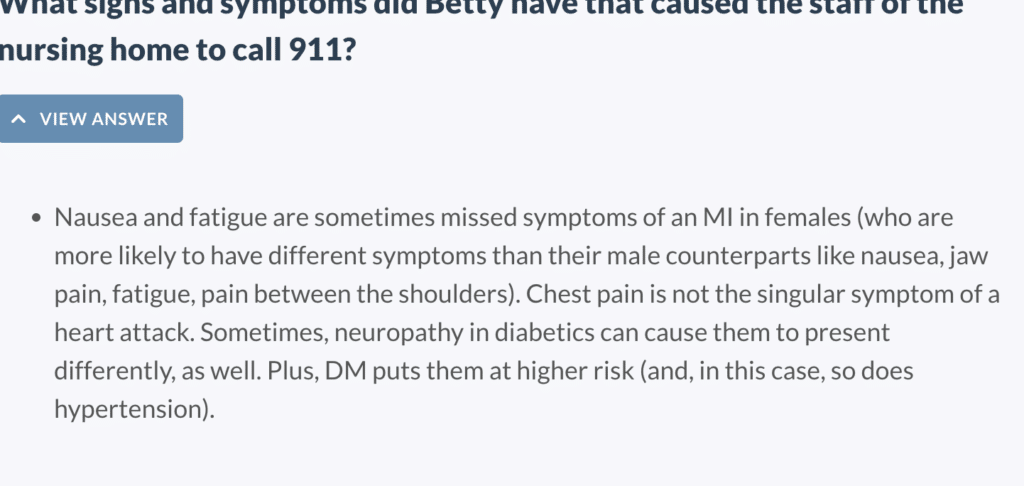
4. Watch the unfolding case study video
The case study will now unfold and the situation will progress just as it would in "real-life".
5. Take the post lesson quiz
After completing the full case study (this should take about 30-60 min) the student should take the post lesson quiz. These quizzes are designed to cover the disease process - not the case study - this is designed to evaluate overall understanding of the given disease.
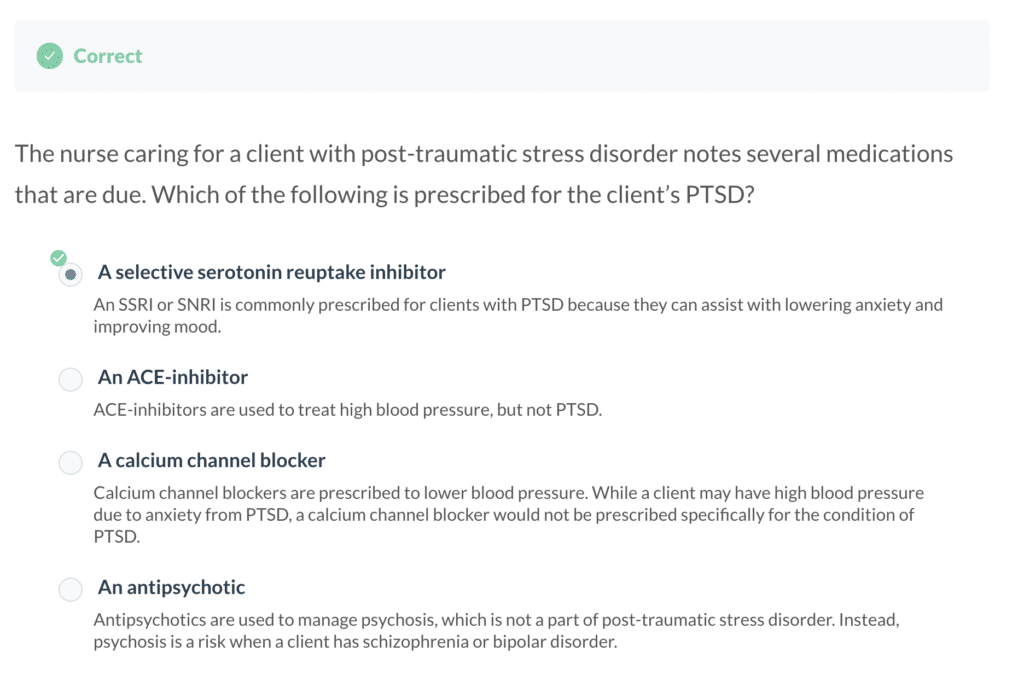
6. Review Attached study tools
Each nursing case study lesson includes various study tools. These act as visual learning elements for the visual leaner. Nursing is REAL-LIFE - it's not just textbooks. Study tools help to connect what is read and viewed to something tangible and real.
View ALL Nursing Case Studies
Nursing case studies are unfolding clinical scenarios that help nursing students develop critical thinking. NURSING.com case studies provide “real-world” examples for nursing students to practice their nursing judgement in a safe environment.
Nursing case studies are pretty complicated to write. At NURSING.com, our case studies are written by practicing nurses with advanced degrees who have direct patient care experience taking care of those with the specific disease process. This gives the nursing student assurance that they are highly realistic.
Unfolding means that the case study progresses via a developing scenario. The nursing student is given assessment data and asked to developing a nursing care plan – the case study then progresses (or unfolds) with new information and the student must adapt their plan . . . sound like the nursing processes?!
💬 Reviews for NURSING.com
(from students like you).


5 Nursing Case Study Examples + Answer Guide

If you're a nursing student preparing for your nursing license exam , you know how important it is to have access to high-quality study materials.
Sample case study for nursing students can be a valuable tool in your preparation, helping you to develop critical thinking skills and apply your knowledge in real-world scenarios.
That's why we've put together a list of 5 nursing case study examples, complete with answer guides, to help you prepare for the NCLEX -style questions you'll encounter on exam day. You can also generate a case study question like the one you will see on the exam; just ask Smart’n.
Nursing Case Study: Mrs. Johnson's hypertension
Background of mrs. johnson’s hypertension.
Mrs. Johnson is a 62-year-old female who was admitted to the hospital with a complaint of severe headache and dizziness. She has a past medical history of hypertension for the past 5 years, and she has been on antihypertensive medications.
She has a family history of hypertension and heart disease, with her mother and brother both diagnosed with hypertension. Mrs. Johnson is currently working as a school teacher and lives with her husband. She has a sedentary lifestyle and reports occasional non-adherence to her medications due to forgetfulness.
Nurse notes of Mrs. Johnson’s hypertension
Upon admission, Mrs. Johnson's vital signs are as follows: blood pressure (BP) 180/100 mmHg, heart rate (HR) 88 beats per minute (BPM), respiratory rate (RR) 18 breaths per minute, and temperature 98.6°F.
She is alert and oriented but complains of a throbbing headache and lightheadedness. Her skin is warm and dry, and there is no visible edema. Her lungs are clear on auscultation, and her heart sounds are normal with no murmurs. Her abdominal assessment reveals no tenderness or masses. Mrs. Johnson's laboratory results show an elevated fasting blood glucose level of 135 mg/dL, cholesterol level of 240 mg/dL, and serum creatinine level of 1.2 mg/dL. She has a body mass index (BMI) of 30, which indicates obesity.
Questions and answer guide of case study
1. What are the risk factors for hypertension in this case study?
Family history of hypertension and heart disease
Sedentary lifestyle
Non-adherence to medications
2. What are the signs and symptoms of hypertension in Mrs. Johnson?
Severe headache
Elevated blood pressure (180/100 mmHg)
3. What other assessments should the nurse prioritize for Mrs. Johnson?
Regular monitoring of blood pressure
Monitoring of blood glucose and cholesterol levels
Assessment of adherence to medications
Assessment of lifestyle factors, such as physical activity and diet
4. What nursing interventions would be appropriate for Mrs. Johnson's hypertension management?
Administer antihypertensive medications as ordered
Educate Mrs. Johnson and her husband on the importance of medication adherence
Encourage regular physical activity and a healthy diet
Monitor and manage blood glucose and cholesterol levels
Provide education on stress management techniques
Collaborate with the healthcare provider to adjust medications and treatment plans as needed
5. What patient education should the nurse provide to Mrs. Johnson regarding hypertension management?
Importance of adhering to antihypertensive medications as prescribed
Adoption of a healthy lifestyle, including regular exercise and a well-balanced diet
Monitoring and management of blood glucose and cholesterol levels
Strategies for stress management
Importance of regular follow-up appointments with the healthcare provider for monitoring and adjustments to the treatment plan
6. What referrals or consultations should the nurse consider for Mrs. Johnson?
Registered dietitian for nutritional counselling
A social worker for assistance with lifestyle modifications and stress management
Diabetes educator for management of blood glucose levels
Pharmacist for medication review and education
Healthcare provider for possible adjustment of antihypertensive medications or referral to a specialist, such as a cardiologist or endocrinologist.
Want access to 25 more unfolding case studies with answer rationales?
Sign up to Smart ’ n to access, for a limited time it’s free for students and aspiring nurses.

Example of a realistic NGN-style case study on Smart’n.
Nursing Case Study: Mr. Thompson's diabetic foot ulcer
Background of mr. thompson’s diabetic foot ulcer.
Mr. Thompson is a 68-year-old male with a history of type 2 diabetes for the past 15 years. He has a sedentary lifestyle and a BMI of 32, indicating obesity. Mr. Thompson has a history of poor glycemic control with frequent episodes of hyperglycemia and occasional non-adherence to his diabetic medications due to financial constraints.
He presents to the clinic with a complaint of a non-healing ulcer on his right foot for the past 2 weeks. He reports that he accidentally bumped his foot against a hard object and developed a small blister that has since progressed to a deep, painful ulcer with foul-smelling drainage.
Assessment of Mr. Thompson’s diabetic foot ulcer
Upon assessment, Mr. Thompson's vital signs are stable with a blood pressure (BP) of 132/82 mmHg, heart rate (HR) of 76 beats per minute (BPM), respiratory rate (RR) of 18 breaths per minute, and temperature of 98.2°F.
He appears anxious and in mild distress due to the pain from the foot ulcer. His right foot is swollen, erythematous, and warm to the touch, with a deep, irregularly-shaped ulcer measuring approximately 3 cm x 4 cm on the plantar surface.
There is purulent drainage with a foul odor, and the surrounding skin is macerated. Mr. Thompson has diminished sensation in his right foot and a weak dorsalis pedis pulse. His laboratory results show an elevated fasting blood glucose level of 240 mg/dL and a hemoglobin A1c level of 9.5%.
1. What are the risk factors for the development of diabetic foot ulcer in Mr. Thompson?
History of type 2 diabetes for 15 years
Poor glycemic control with frequent episodes of hyperglycemia
Non-adherence to diabetic medications
Sedentary lifestyle and obesity
Foot injury due to accidental trauma
2. What are the signs and symptoms of the diabetic foot ulcer in Mr. Thompson?
Deep, irregularly-shaped ulcer with foul-smelling drainage
Swollen, erythematous, and warm foot
Macerated skin surrounding the ulcer
Diminished sensation and weak pulse in the affected foot
3. What other assessments should the nurse prioritize for Mr. Thompson's diabetic foot ulcer management?
Assessment of pain level and pain management
Assessment of wound characteristics, including size, depth, drainage, odor, and surrounding skin condition
Neurovascular assessment, including sensation, pulses, and skin temperature
Assessment of glycemic control and diabetes management
Assessment of nutritional status and hydration
4. What nursing interventions would be appropriate for Mr. Thompson's diabetic foot ulcer management?
Administering prescribed analgesics for pain management
Performing wound care, including cleansing, debridement, and dressing changes
Educating Mr. Thompson on proper foot care, including daily inspection, keeping the foot clean and dry, and avoiding trauma
Assisting with glycemic control through medication administration, dietary management, and regular blood glucose monitoring
Facilitating referrals to a wound care specialist, podiatrist, or diabetes educator as needed
Educating Mr. Thompson and his family on the importance of adherence to diabetic medications and lifestyle modifications
5. What patient education should the nurse provide to Mr. Thompson regarding diabetic foot ulcer management?
Proper foot care techniques, including daily foot inspection, keeping the foot clean and dry, and avoiding trauma
Importance of adherence to diabetic medications and lifestyle modifications for glycemic control
Signs and symptoms of infection, such as increased pain, redness, swelling, or drainage, and when to seek medical attention
Appropriate footwear selection and fitting to prevent further foot injury
Importance of regular follow-up appointments with healthcare providers for ongoing monitoring and management of diabetes and foot ulcer
Nutritional recommendations for diabetes management, including a balanced diet and avoiding high-sugar foods and beverages
Importance of maintaining a healthy weight through lifestyle modifications, including regular physical activity and healthy eating habits
Emphasizing the need for strict glycemic control to promote wound healing and prevent complications
Instruction on the proper administration of prescribed medications, including dosages, timing, and potential side effects
Education on the risks and consequences of non-adherence to diabetes management and foot care recommendations
6. What interdisciplinary team members may be involved in Mr. Thompson's diabetic foot ulcer management?
Primary care physician or endocrinologist for diabetes management
Wound care specialist or podiatrist for specialized wound care and management
Diabetes educator for diabetes education and self-management strategies
Registered dietitian for nutritional counseling
Pharmacist for medication management and education
Physical therapist for recommendations on appropriate physical activity and exercise
A social worker or financial counselor for assistance with financial constraints related to medication affordability
Ask Smart’n, the GPT for nurses to build you a case study like one you wlll see on the NCLEX exam
Nursing Case Study: Mich’s chest pain
Background of mich’s chest pain.
Mich is a 15-year-old male who was brought to the emergency department by his parents due to complaints of chest pain and shortness of breath. Mich has a history of asthma and had been experiencing symptoms for the past two days. Mich's parents reported that he had been compliant with his asthma medications but had recently run out of his inhaler. Upon arrival at the emergency department, Mich was found to have a rapid heart rate and was diagnosed with a severe asthma exacerbation.
Assessment of Mich’s chest pain
On assessment, Mich appeared anxious and in distress, with labored breathing and a respiratory rate of 30 breaths per minute. His oxygen saturation was 88% on room air, and he was immediately started on supplemental oxygen via nasal cannula.
Mich's chest exam was significant for decreased breath sounds and wheezing. His heart rate was 130 beats per minute, and his blood pressure was 120/70 mmHg. Mich's laboratory values were within normal limits, except for an elevated white blood cell count, which was likely due to his asthma exacerbation.
1. What is the priority nursing intervention for Mich?
The priority nursing intervention for Mich is to assess and manage his respiratory distress. This includes providing supplemental oxygen, administering bronchodilator medications, and monitoring his response to treatment.
2. What education should the nurse provide to Mich and his parents?
The nurse should educate Mich and his parents on the proper use of asthma medications, including inhalers and nebulizers. The nurse should also provide education on asthma triggers and how to avoid them, as well as signs and symptoms of an asthma exacerbation and when to seek medical attention.
3. What potential complications should the nurse monitor for in Mich?
The nurse should monitor Mich for potential complications of asthma exacerbation, including respiratory failure, pneumothorax, and cardiac complications such as arrhythmias. The nurse should also monitor for signs of anxiety and provide emotional support to Mich and his family.
4. How can the nurse promote adherence to Mich's asthma treatment regimen?
The nurse can promote adherence to Mich's asthma treatment regimen by providing education and resources, such as written instructions and referrals to support groups. The nurse can also encourage open communication with Mich and his family and address any barriers to adherence, such as cost or access to medications.
5. What discharge planning should the nurse initiate for Mich?
The nurse should initiate discharge planning that includes instructions for Mich and his family on proper asthma management at home. This includes providing education on medication administration, recognizing signs and symptoms of asthma exacerbation, and developing an asthma action plan. The nurse should also ensure that Mich has access to his medications and any necessary equipment, such as a peak flow meter or spacer. Referral to a primary care provider or asthma specialist for ongoing management should also be initiated. Finally, the nurse should provide education on follow-up appointments and any necessary referrals for additional support services, such as social work or mental health resources.
6. How can the nurse promote family-centered care for Mich and his parents?
The nurse can promote family-centered care by involving Mich and his parents in the care planning process and encouraging their participation in decision-making. The nurse can provide emotional support and education to help them feel confident in their role as caregivers, and address any cultural or religious needs of the family to promote a holistic approach to care. The nurse should also encourage family visitation and provide opportunities for Mich and his parents to ask questions and express concerns.
Want more case studies with full-answer rationales tailored to you? just ask Smart’n. It’s easy to try, and it’s free.
Nursing Case Study: Baby S - Respiratory distress and hypoxemia
Background of baby’s respiratory distress and hypoxemia.
Baby S is a 10-day-old infant who was admitted to the neonatal intensive care unit (NICU) due to respiratory distress and hypoxemia. Baby S was born prematurely at 34 weeks gestation via emergency cesarean section due to fetal distress.
The mother had a history of preeclampsia and received antenatal corticosteroids. Baby S had a birth weight of 2.2 kg and required immediate intubation and mechanical ventilation.
Assessment of baby’s respiratory distress and hypoxemia
On assessment, Baby S appeared to be in moderate respiratory distress, with a respiratory rate of 50 breaths per minute, nasal flaring, and intercostal retractions. Her oxygen saturation was 88% on a fraction of inspired oxygen (FiO2) of 0.5, and her heart rate was 160 beats per minute. Lung auscultation revealed bilateral crackles, and the chest X-ray showed diffuse bilateral infiltrates consistent with respiratory distress syndrome (RDS). Baby S had a central line for parenteral nutrition and was receiving intravenous fluids and medications.
1. What is the pathophysiology of RDS in premature infants?
RDS is a common respiratory disorder in premature infants, caused by a deficiency of pulmonary surfactant, which normally keeps the alveoli open and prevents collapse. In premature infants, the lungs are not fully developed, and surfactant production is inadequate, leading to increased surface tension and collapse of the alveoli. This results in ventilation-perfusion (V/Q) mismatch, hypoxemia, and respiratory distress.
2. What interventions should the nurse implement for Baby S?
The nurse should ensure that Baby S is receiving appropriate respiratory support, including mechanical ventilation, FiO2 titration, and positive end-expiratory pressure (PEEP) as prescribed. The nurse should also monitor Baby S's vital signs, oxygen saturation, and blood gas values closely to optimize oxygenation and ventilation. The nurse should maintain a sterile environment around the central line and monitor for signs of infection. The nurse should also provide enteral or parenteral nutrition as prescribed to meet the infant's metabolic needs and promote growth.
3. What potential complications should the nurse monitor for in Baby S?
The nurse should monitor for potential complications such as infection, barotrauma, bronchopulmonary dysplasia (BPD), and patent ductus arteriosus (PDA). Infection is a common complication in premature infants and can be life-threatening. Barotrauma can occur due to excessive mechanical ventilation and can result in pneumothorax or other complications. BPD is a chronic lung disease that can develop in premature infants who require prolonged mechanical ventilation or oxygen therapy. PDA is a common cardiac complication in premature infants, resulting in abnormal blood flow between the aorta and pulmonary artery.
4. How can the nurse support Baby S's developmental care needs?
The nurse can support Baby S's developmental care needs by providing a quiet and dark environment, minimizing unnecessary handling and stimulation, and promoting restful sleep. The nurse can also encourage skin-to-skin contact with the mother or father to promote bonding and provide comfort. The nurse should also provide appropriate pain management for any procedures or interventions to minimize discomfort and stress.
5. What discharge planning should the nurse initiate for Baby S?
The nurse should initiate discharge planning as early as possible to ensure a smooth transition to home. The nurse should provide education to the parents about the infant's medical needs, including respiratory support, feeding, medication administration, and infection prevention. The nurse should also refer the parents to appropriate community resources, such as home health services, support groups, and developmental follow-up clinics. The nurse should work with the healthcare team to develop a plan for ongoing monitoring and follow-up to ensure that Baby S's medical needs are being met and to monitor for any potential complications or developmental delays.
6. How can the nurse promote family-centered care for Baby S and her parents?
The nurse can do so by involving the parents in the infant's care as much as possible, encouraging their participation in decision-making, and providing emotional support and education to help them feel confident in their role as caregivers. The nurse can also encourage family visitation and provide opportunities for parent-infant bonding, such as skin-to-skin contact and feeding. The nurse should also recognize and address any cultural or religious needs of the family to promote a holistic approach to care.
Want more case studies with full-answer rationales tailored to you? Just ask Smart’n. Try it now, it’s free .
Nursing Case Study: Mrs. Jones - Postoperative care after total hip replacement surgery
Background of mrs. jones’ hip replacement surgery.
Mrs. Jones is a 72-year-old female who underwent total hip replacement surgery due to severe hip osteoarthritis. She has a history of hypertension and osteoporosis. Mrs. Jones lives alone and has limited mobility due to hip pain and stiffness prior to surgery. She was admitted to the orthopedic surgical unit and is now postoperative day 1 after her surgery.
Assessment of Mrs. Jones’ hip replacement surgery
Mrs. Jones is alert and oriented but reports pain at the surgical site rated 7/10 on the pain scale.
Vital signs: Blood pressure 140/90 mmHg, heart rate 88 bpm, respiratory rate 18 bpm, temperature 98.6°F.
Surgical incision: 15 cm incision over the lateral aspect of the right hip, with moderate serosanguinous drainage.
Limited weight-bearing status on the right leg as per surgeon's orders.
Foley catheter in place for urinary drainage.
Serosanguinous drainage in the surgical drain.
Evaluation of Mrs. Jones’ hip replacement surgery
Mrs. Jones's pain is well managed, with her pain level reduced to 4/10 on the pain scale within 24 hours post-surgery.
Mrs. Jones is able to perform transfers and ambulation with appropriate assistive devices as per the prescribed weight-bearing status.
There are no signs of infection at the surgical site or systemic infection.
Mrs. Jones and her family demonstrate an understanding of the postoperative care plan, including pain management, mobility restrictions, and infection prevention measures.
Mrs. Jones's home environment is assessed to be safe for her discharge, and necessary home health services, medical equipment, or rehabilitation services are arranged.
Questions and answer guide of Case Study
1. What are the priority nursing diagnoses for Mrs. Jones?
Acute Pain related to surgical incision and tissue trauma
Impaired Physical Mobility related to postoperative weight-bearing restrictions
Risk for Infection related to the surgical site and indwelling catheter
2. What are the nursing interventions to address Mrs. Jones's acute pain?
Assess pain level using a numeric pain scale at regular intervals and as needed.
Administer prescribed pain medications, such as acetaminophen and opioids, as ordered and monitor for side effects.
Apply ice or heat to the surgical site as appropriate to help relieve pain and reduce swelling.
Use non-pharmacological pain relief measures, such as relaxation techniques and distraction techniques, to help Mrs. Jones manage her pain.
3. How can the nursing team assist Mrs. Jones with impaired physical mobility?
Assist Mrs. Jones with transferring and ambulation according to the prescribed weight-bearing status and mobility orders.
Educate Mrs. Jones on the proper use of assistive devices, such as crutches or a walker, and provide assistance as needed.
Collaborate with the physical therapy team to develop a plan of care for Mrs. Jones's mobility and ambulation post-surgery.
Encourage Mrs. Jones to perform a range of motion exercises as tolerated to prevent joint stiffness and muscle atrophy.
4. What nursing interventions can be implemented to prevent infection in Mrs. Jones?
Perform frequent hand hygiene and use appropriate personal protective equipment (PPE) when providing care to Mrs. Jones, especially when handling the surgical drain or catheter.
Monitor the surgical incision for signs of infection, such as redness, increased warmth, swelling, or purulent drainage, and report any abnormal findings to the healthcare provider.
Monitor vital signs, including temperature, for signs of systemic infection.
Ensure proper care and maintenance of the indwelling catheter according to the facility's policy and procedure.
5. What should be included in Mrs. Jones's education and discharge planning?
Provide Mrs. Jones and her family with education on the postoperative care plan, including pain management, mobility restrictions, and infection prevention measures.
Provide written materials and verbal instructions on wound care, medication administration, activity restrictions, and follow-up appointments.
Collaborate with the interdisciplinary team, including the physical therapist and social worker, to assess Mrs. Jones's home environment and ensure a safe discharge plan.
Assist with coordinating any necessary home health services, medical equipment, or rehabilitation services for Mrs. Jones's post-discharge care.
6. How will the nursing team evaluate the effectiveness of the care provided to Mrs. Jones?
Monitor Mrs. Jones's pain level and assess for any side effects of pain medications.
Assess Mrs. Jones's ability to perform transfers and ambulation with assistive devices.
Monitor the surgical incision and vital signs for signs of infection.
Evaluate Mrs. Jones's and her family's understanding of the education provided and their ability to implement the postoperative care plan.
Collaborate with the interdisciplinary team to ensure a safe and appropriate discharge plan for Mrs. Jones.
Want to access 25 more case studies with full-answer rationales?
Nurses can ask Smart ’ n anything for instant, trustworty answers—and access 25 top NCLEX case-studies in study mode.
55 Types Of Nursing Jobs In 2023 + Salaries
Understanding the different types of case studies in 2023.

IMAGES
COMMENTS
Aug 17, 2023 · Discover a wide range of comprehensive nursing case study examples and solutions that cover various medical specialties and scenarios. These meticulously crafted case studies offer real-life patient scenarios, providing you with a deeper understanding of nursing practices and clinical decision-making processes.
Jun 21, 2024 · A nursing case study is a detailed study of an individual patient, which allows you to gain more information about the symptoms and the medical history of a patient and provide the proper diagnoses of the patient’s illness based on the symptoms he or she experienced and other affecting factors.
39 Things Every Nursing Student Needs Before Starting School More... At NURSING.com, we believe Black Lives Matter 🏿, No Human Is Illegal 🤝, Love Is Love 🏳️🌈, Women`s Rights Are Human Rights 👩, Science Is Real 🔬, Water Is Life 🌊, Injustice Anywhere Is A Threat To Justice Everywhere ☮️.
Nursing Case Studies: Diagnosis, Rationales, Fundamentals Test your knowledge and clinical investigative skills in trying to diagnose what is going on with the patients presented in each of the Case Study Investigations.
Nursing Case Study 2200 – OB Ward Submitted By: Liana Monique San Lorenzo BSN3-2; RLE Group 2 Submitted to: Ms. Vicencio October 15, 2013 NURSING CASE STUDY ADMISSION DIAGNOSIS: G2P1 (1001) Pregnancy, Uterine,Term, Cephalic FINAL DIAGNOSIS: G2P2 (2002) Pregnancy, Uterine,Term, Cephalic Delivered, Live birth by VSD with right
Nov 11, 2024 · Writing a nursing case study involves several essential steps to ensure accuracy, relevance, and clarity. Let's break down the process into actionable steps: Begin by selecting a patient case that presents a relevant and compelling healthcare scenario.
Nursing Case Study I. Health History The subject of my case study is W. K. W.K. is a 95 year old white male who was admitted to Moses Cone Hospital on November 23, 2002. Prior to being admitted to the hospital, W. K. had been in excellent health. His troubles apparently began three weeks prior to being admitted.
Oct 16, 2024 · A nursing case study is a vital aspect of any medical student’s life. These case studies teach students how they apply theoretical knowledge in a practical world setting. Below is the free nursing case that will aid you in composing a winning case study.
59 unfolding nursing case studies with answers developed by practicing ED/ICU nurses that improve critical thinking. The perfect solution for "low fidelity" clinical replacement. Click on a case study below to view in our Nursing Case Study Examples course which holds all of our 40+ nursing case studies with answers.
Apr 27, 2023 · That's why we've put together a list of 5 nursing case study examples, complete with answer guides, to help you prepare for the NCLEX -style questions you'll encounter on exam day. You can also generate a case study question like the one you will see on the exam; just ask Smart’n.